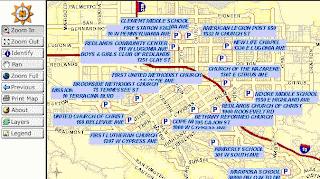
This was just published in "InPrint" (Azteca's industry publication). Authors: Philip Mielke of Redlands, Matt Harman from Azteca
Azteca Systems provides two implementation methods to
assist clients with their deployment of Cityworks — standard
implementation and Remote Implementation Support (RIS).
A brief description of both methods follows. Both involve an
Azteca Project Manager (PM) assigned to manage the effort
and deliver the tasks from beginning to end. Several of
Azteca’s customers have experienced great success (and cost
savings since the bulk of the work is performed in-house)
with RIS. Most recently the City of Redlands, CA, chose RIS
to deploy Cityworks.
Standard ImplementationIn a standard implementation, the Azteca PM is responsible
for a larger portion of the workload and configuration. The
tasks typically include a kickoff meeting, configuration/
implementation of workflows, review and installation of the
configured database/system, administrative training, end
user training, and rollout support. This method averages
about three months from start to finish, depending on the
number of departments being implemented and the number
of users being trained.
Remote Implementation SupportIn this approach, the Azteca PM meets with the organization’s
representative through a series of webcast meetings to
implement the Cityworks software. (Meetings average
2-3 hours and are billed incrementally.) RIS is made
up of two primary tasks — implementation and training.
Implementation provides hands-on instruction for the
installation of the software and database, and all the
necessary configuration in Designer. (Designer is the
Cityworks administration tool used to define workflows and
related elements.) At the end of each meeting, the client’s
“homework” is to complete what was covered. When the
work is completed, a meeting takes place for the next lesson
and the process is repeated until the implementation is
complete. There is a standard list of lessons/topics covered
but, similar to the standard implementation, the content can
be tailored to the needs/goals of the organization.
Once the database and system configuration is complete,
training can be provided onsite or remotely via webcast. Or,
in some instances the client has been able to conduct their
own internal training as a result of the education gleaned
through RIS. Delivery time is subjective and moves at the
pace the organization sets.
Redlands GISRedlands is a city of approximately 70,000 nestled in the
San Bernardino Mountains in the Inland Empire of Southern
California. Since May of 2008, Azteca has
been working with Phil Mielke (Interim GIS
Administrator) and Marc Rolle (Database
Analyst) to configure Cityworks for the Quality
of Life and Municipal Utilities & Engineering
departments. Redlands has a variety of land uses and levels
of development, so providing service to the people and
businesses presents unique challenges. Like many cities,
Redlands has a growing need to reduce spending and take
measures to increase efficiency of work crews. Central to
that need is a work order system that utilizes a Geographic
Information System (GIS) to process work orders from call to
assignment through to completion.
The Redlands Information Technology Service Department
has incorporated GIS into nearly every aspect of City
operation. The Redlands Police Department has been a
long-time user of ESRI products and practices efficient
community policing through the sharing of information and
mapping through GIS. Citizen COMPASS, a tool developed
to share crime data with the public, is accessible through
gis.cityofredlands.org/compass. Redlands GIS Department
utilizes ESRI’s enterprise GIS licensing and supports 20
individual deployments, including instances of ArcGIS Server,
ArcSDE, and ArcIMS. Part of the philosophy of the enterprise
deployment allows users to take ownership of their use of
GIS. People with the domain knowledge take responsibility
for the quality of their data and become more knowledgeable
about the way their data can interact with other City
information.
Phil summarizes the City’s approach to maintaining their
operation. “Cityworks is the perfect solution for us to
incorporate GIS users from customer service to supervisors
to line-level operators. Information is easily accessible and
delivered through a clear and easy-to-use interface. Reports
give decision makers the information they need to be able
make informed decisions about where work is being done,
what materials are used, and how much money is being
spent for work orders grouped by any date interval
required. Cityworks saves the City of Redlands money
and is a great way to make the power of GIS accessible
to a broader group of users.”
Redlands RISAt the beginning of the project, the project outline was
provided covering the steps required to complete the
implementation. Each week thereafter, web meetings
were held to train Phil and Marc on how to configure
the Cityworks topic for that week. These meetings are
hosted by Azteca Systems via the GoToMeeting software
produced by Citrix Systems. GoToMeeting allows both
the Azteca PM and the new client to view and control
each other’s computers via the internet. This web
meeting interaction allows for more effective training as
both the trainer and trainee can actually view what is
being described during the conference call.
Marc says, “The web meetings via GoToMeeting were so
convenient and very helpful during the implementation
process of Cityworks. There was no lag in connectivity
whatsoever! Having the capability to view each other’s
computer screen makes it much easier to learn the
system remotely. It seemed as if Matt was sitting next to
me showing me what to do. Also, we were able to record
the meetings (both audio and visual). So if we need a
refresher of how to do things, we simply go back to the
recordings and follow the step-by-step solutions that Matt
illustrated to us.“
The outline of the project progresses through each
component of Cityworks, building upon each other until
the software is ready to be used. Meeting durations
were typically 2 hours, during which the week’s topic
was demonstrated on a completed Cityworks database
(running on Matt’s machine) and then Phil and Marc
added the information and configured the week’s topic for
their database. The goal of the weekly meetings was to
provide sufficient training so both Phil and Marc could add
to the database throughout the week, circling back with
follow-up questions as needed. Cityworks administrators
gain valuable knowledge by actually performing these
tasks themselves.
In addition, the RIS approach also allows for training end
users on Cityworks via GoToMeeting. In Redlands, once
the database was ready to use for service requests, a
web meeting was set up to train some of the call takers
on the software. They received basic training on creating
service requests. The training sessions were recorded so
they can be used at a later time to train other users or as
a refresher for existing users.
As the project progressed, both Phil and Marc gained the
knowledge necessary to perform the remaining tasks to
complete the configuration of the software. At this time,
they are currently running live with service requests. As
for future use of the software, Phil and Marc dictate the
pace of the project themselves, asking for assistance
Project Outline
as needed. They plan to move forward with work orders and
include additional departments as time permits over the coming
months. At a later date, on-site training will be conducted for
the remaining end users.
RIS is an excellent option for those municipalities looking for a
more cost-effective and hands-on implementation of Cityworks.
GoToMeeting provides a virtual office environment in which
the Azteca PM can interact effectively with the City staff to
demonstrate, train, assist, and oversee the configuration of the
Cityworks software.
ID Task Name1 Database Creation
2 Install RDBMS on Server (if necessary)
3 Install Cityworks on Server
4 Create New Cityworks Database
5 Create User Azteca
6 Create PWDP USER Role
7 Create ODBC Connection
8 Run DB Manager
9 Cityworks Domains
10 Add Super User Login
11 Add Domain Names
12 Add Domain Administrators
13 Designer Preferences per Domain
14 Domain Groups
15 Create Employee/Security Domain Groups
16 Add Employees to Groups
17 Employees
18 Import Employees with Rates
19 Create Logins on Server
20 Add Employee Custom Fields
21 Add Skills
22 Set Employee Relates
23 ArcGIS Setup
24 Review Geodatabase Model
25 Add Required Attribute Fields
26 Define Asset Groups
27 Assign Assets
28 Define Relationships
29 Create .mxd(s)
30 Import/Enter Data
31 Contractors
32 Equipment
33 Materials
34 Customer Accounts
35 Street Codes
36 Request Templates
37 Define Problem Codes
38 Add to Hierarchy
39 Questions/Answers
40 Security
41 Custom Field Templates
42 Work Order Templates
43 Define Work Order Activities
44 Import Work Order Descriptions
45 Tasks
46 Custom Field Templates
47 Security
48 Print Templates
49 Service Request
50 Work Order
51 Codes
52 Add All Codes (Priority, Status, etc.)
53 Final Review and Rollout
54 Review Databa


















